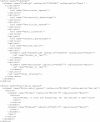Conversion of Radiology Reporting Templates to the MRRT Standard
- PMID: 25776768
- PMCID: PMC4570901
- DOI: 10.1007/s10278-015-9787-3
Conversion of Radiology Reporting Templates to the MRRT Standard
Abstract
In 2013, the Integrating the Healthcare Enterprise (IHE) Radiology workgroup developed the Management of Radiology Report Templates (MRRT) profile, which defines both the format of radiology reporting templates using an extension of Hypertext Markup Language version 5 (HTML5), and the transportation mechanism to query, retrieve, and store these templates. Of 200 English-language report templates published by the Radiological Society of North America (RSNA), initially encoded as text and in an XML schema language, 168 have been converted successfully into MRRT using a combination of automated processes and manual editing; conversion of the remaining 32 templates is in progress. The automated conversion process applied Extensible Stylesheet Language Transformation (XSLT) scripts, an XML parsing engine, and a Java servlet. The templates were validated for proper HTML5 and MRRT syntax using web-based services. The MRRT templates allow radiologists to share best-practice templates across organizations and have been uploaded to the template library to supersede the prior XML-format templates. By using MRRT transactions and MRRT-format templates, radiologists will be able to directly import and apply templates from the RSNA Report Template Library in their own MRRT-compatible vendor systems. The availability of MRRT-format reporting templates will stimulate adoption of the MRRT standard and is expected to advance the sharing and use of templates to improve the quality of radiology reports.
Keywords: Infrastructure; Integrating the Healthcare Enterprise (IHE); MRRT; Radiology reporting; Reporting; Standards; Structured reporting.
Figures








Similar articles
-
Development of an IHE MRRT-compliant open-source web-based reporting platform.Eur Radiol. 2017 Jan;27(1):424-430. doi: 10.1007/s00330-016-4344-0. Epub 2016 Apr 30. Eur Radiol. 2017. PMID: 27137649
-
Enabling the Next-Generation Radiology Report: Description of Two New System Standards.Radiographics. 2017 Nov-Dec;37(7):2106-2112. doi: 10.1148/rg.2017160106. Epub 2017 Oct 2. Radiographics. 2017. PMID: 28968194
-
[Reporting initiatives. An update on treatment in radiology].Radiologe. 2014 Jul;54(7):696-9. doi: 10.1007/s00117-014-2681-z. Radiologe. 2014. PMID: 24989877 Review. German.
-
An open-standards grammar for outline-style radiology report templates.J Digit Imaging. 2012 Jun;25(3):359-64. doi: 10.1007/s10278-012-9456-8. J Digit Imaging. 2012. PMID: 22258732 Free PMC article.
-
Potential use of extensible markup language for radiology reporting: a tutorial.Radiographics. 2000 Jan-Feb;20(1):287-93. doi: 10.1148/radiographics.20.1.g00ja28287. Radiographics. 2000. PMID: 10682794 Review.
Cited by
-
Structured reporting of chest CT in COVID-19 pneumonia: a consensus proposal.Insights Imaging. 2020 Aug 12;11(1):92. doi: 10.1186/s13244-020-00901-7. Insights Imaging. 2020. PMID: 32785803 Free PMC article.
-
Structured reporting of computed tomography in the staging of colon cancer: a Delphi consensus proposal.Radiol Med. 2022 Jan;127(1):21-29. doi: 10.1007/s11547-021-01418-9. Epub 2021 Nov 6. Radiol Med. 2022. PMID: 34741722 Free PMC article.
-
Glioma imaging in Europe: A survey of 220 centres and recommendations for best clinical practice.Eur Radiol. 2018 Aug;28(8):3306-3317. doi: 10.1007/s00330-018-5314-5. Epub 2018 Mar 13. Eur Radiol. 2018. PMID: 29536240 Free PMC article.
-
Computed Tomography Structured Reporting in the Staging of Lymphoma: A Delphi Consensus Proposal.J Clin Med. 2021 Sep 4;10(17):4007. doi: 10.3390/jcm10174007. J Clin Med. 2021. PMID: 34501455 Free PMC article.
-
Structured Reporting of Computed Tomography and Magnetic Resonance in the Staging of Pancreatic Adenocarcinoma: A Delphi Consensus Proposal.Diagnostics (Basel). 2021 Nov 3;11(11):2033. doi: 10.3390/diagnostics11112033. Diagnostics (Basel). 2021. PMID: 34829384 Free PMC article.
References
-
- Bosmans JM, Weyler JJ, De Schepper AM, Parizel PM: The radiology report as seen by radiologists and referring clinicians: results of the COVER and ROVER surveys. Radiology 259:184–195, 2011 - PubMed
-
- Larson DB, Towbin AJ, Pryor RM, Donnelly LF: Improving consistency in radiology reporting through the use of department-wide standardized structured reporting. Radiology 267:240–250, 2013 - PubMed
MeSH terms
LinkOut - more resources
Full Text Sources
Other Literature Sources

